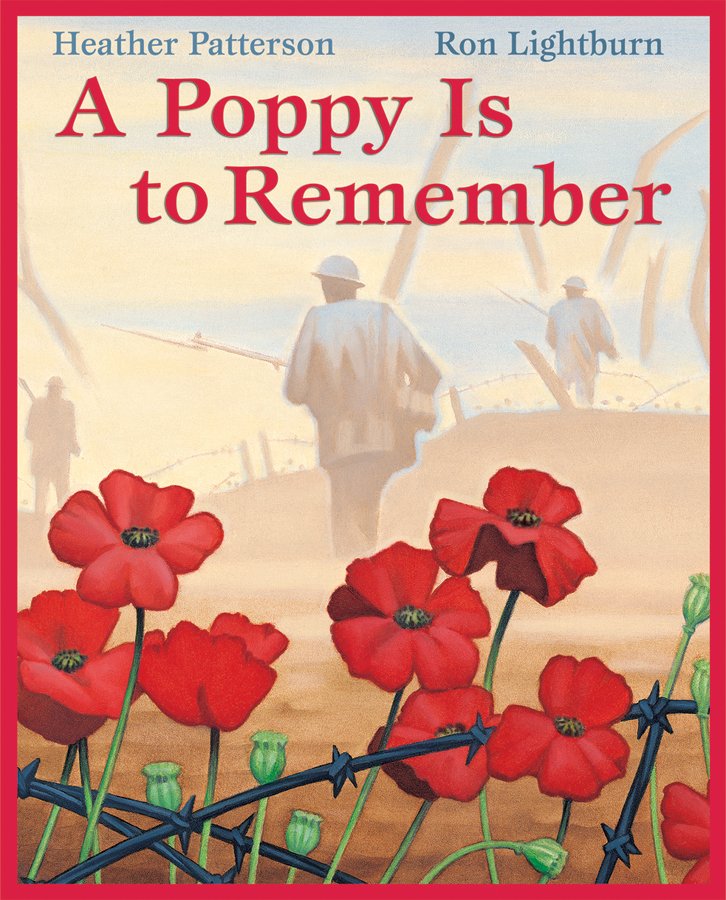8 Kids’ Books to Share for Remembrance Day
Talking about the reality of war can be a challenge, particularly with young children. Here are 8 titles- each meticulously researched and sensitively told for their intended readers- that can help foster these conversations. All of these titles have historical notes providing further context and, in some cases, pointing out the author or illustrator’s personal connection to the story.
Watch the segment online here!
Picture Books, ages 3-7
A Poppy is to Remember (Scholastic) is the perfect introductory book for the youngest reader. In simple and straightforward text it explains why we wear poppies on Remembrance Day and includes the text of the poem In Flanders Fields. There are two historical notes at the back, one for the story of the poppy, and the other for the history of Remembrance Day in Canada, that parents or teachers can use as kids get older or have more questions. The art is rich and warm, lending a classic feel to the book.
Sergeant Billy (Tundra) is the true story of a goat (from Saskatchewan) that was adopted by a platoon of Canadian soldiers and taken overseas during WWI. This book provides a glimpse into life in the trenches, where Billy not only lifts the spirits of the soldiers, but in at least one incident, actually saves their lives. Animals stories are often a good way to introduce kids to the concept and reality of war, and this one gets the balance just right.
In The Brass Charm (Scholastic) a young girl learns about her Oma’s experience in a prison camp. She knows something bad happened to her grandmother, but it isn’t until she is facing her own loss that her Oma tells her the story of the brass charm. This story is based on the author’s mother’s experience in a prison camp, and the brass charm represents an extraordinary act of kindness in the darkest of places.
Ages 7-10
The Prisoner and the Writer (Groundwood) is a spare, illustrated re-telling of the Dreyfus affair, when a Jewish army captain was falsely accused of treason and one writer decided to fight for him in the press. It isn’t specifically about the great wars, but provides historical context of anti-semitism in Europe and demonstrates the importance of speaking out against injustice and holding the powers that be accountable.
Middle Grade, ages 9-12
Stealing Home (KCP) is a humbling and necessary reminder that Canada also committed crimes during The Second World War. This graphic novel tells the story of the Japanese Internment through eyes of a boy whose family is forced to leave their home in Vancouver to live and work in Alberta in extremely poor conditions.
Marsha Skrypuch is a trusted expert in writing war novels for kids, and Traitors Among Us (Scholastic) demonstrates why. This is one in a series of books that focuses on the experiences of two Ukrainian sisters. In this book, the war has ended, but the girls find themselves in a displaced persons camp and then captured by the Soviets and accused of aiding the Nazis. This is a powerful story about what happened after the war, and how complicated the idea of armistice or peace really is.
Hidden on the High Wire (Second Story Press) is about a young, Jewish circus performer who hides in plain sight when a sympathetic circus master takes her and her mother in after their own family circus is forced to close by the Nazis. This is based on the true story of The Lorch Family Circu. Irene’s love for her family and the circus details provide a nice contrast to the tension of what it was like to be Jewish in Germany during the war years.
Teens
Heroine, Rescuers, Rabbies, Spies (Second Story Press) is a collection of stories about nine women from around the world who took extraordinary measures to save lives during the Holocaust. These are people who have largely been ignored by history, but their stories are unforgettable. It’s also an example of how ordinary people can make huge contributions, which is a reminder we can all use.







